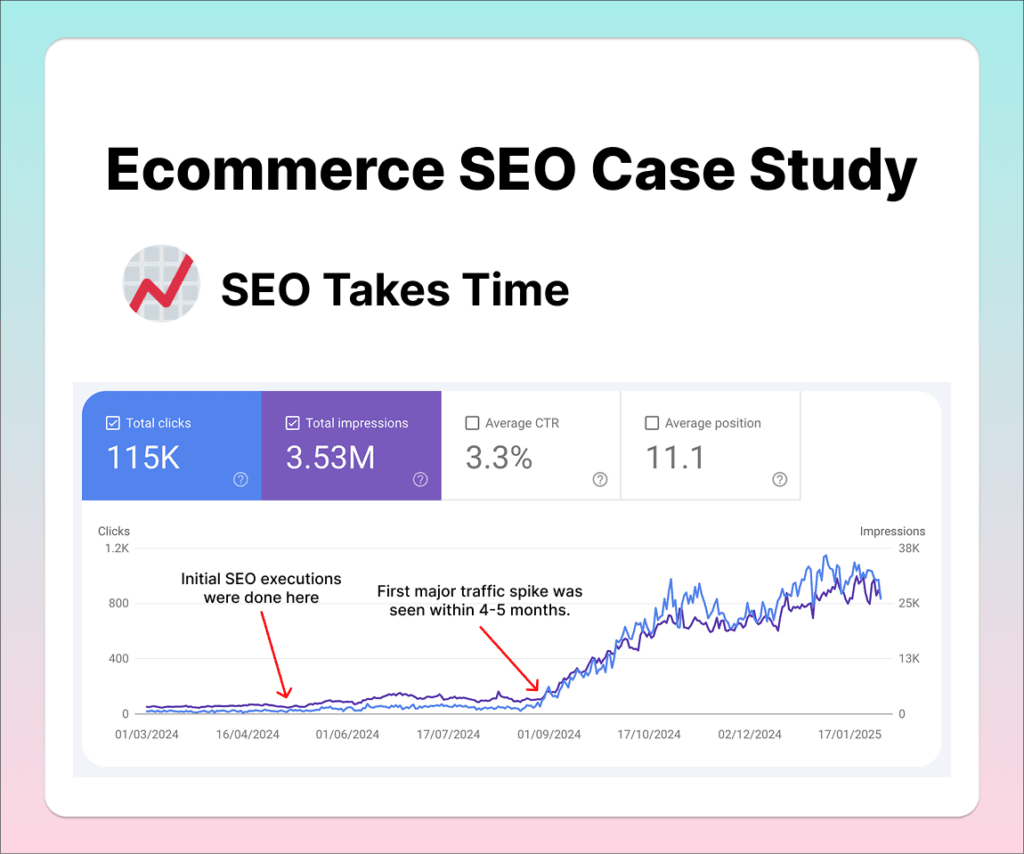Here’s a recent Ecommerce SEO Case Study that I wanted to share and through this case study you’d know my approach to SEO in general and more specifically my approach towards SEO for D2C Brands. First things first, let’s know more about the client.
Client Overview
An Indian D2C Home Decor Brand in business since 2016. We onboarded them in April 2024.
Challenges
- Low Organic Visibility – Only 600 monthly visitors, a small share of the category’s total search volume.
- Inconsistent Rankings – Multiple pages ranked randomly on page 3-4 of Google.
- Duplicate content issues – Indexed Tagged category pages causing ranking problems.
- Lost Rankings to Resellers – Marketplaces with strong backlinks outranked them.
Research Phase
Before planning any SEO strategy, I always start with two key questions:
- 1️⃣ What does Google want?
- 2️⃣ Where do we stand?
We already identified the site’s challenges and problems—now it’s time to uncover why they exist!
To find the answers, we first analyzed Google Search Console for past keyword data and examined Google SERPs directly. Then, we cross-checked insights using SEMrush and Ahrefs.
And here’s our findings after analyzing the website, the bad ones first:
- Lots of product tagged categories causing duplicate content issues and sabotaging ranking potential.
- Unoptimized Titles and H1 Tags.
- No collection page descriptions. (These aren’t necessary as a lot of competitors were ranking without any collection page description but it does help.)
- Weak Backlink profile.
- Poor site architecture and internal linking.
Now, the Good ones:
- Good branded search volume: This is important for SEO as it indicates a strong Brand presence in the real world.
- Brand was spending in Paid advertising and Performance marketing. Being Omnipresent in 2025 is more important than ever.
And here’s our Observation & Conclusion about Search intent after analyzing SERPs for the Target keywords:
OBSERVATION:
- E-commerce sites with more SKUs performed better, even without collection page descriptions.
- Our brand had only 16 SKUs per collection page, while competitors averaged 30-40 SKUs.
- Pinterest & Instagram ranked on the first page for almost all target keywords.
CONCLUSION:
- The search intent and category are highly visual/image-focused and visitors want more options.
The SEO Strategy
After completing the Keyword research and competitor analysis here’s an overview of the Strategy we followed:
1. ON Page Strategy
- Used Keyword rich Titles and Heading Tags.
- Added 200-350 words of optimized content on every collection.
- Increased SKUs from 16 to 24.
- Added keyword rich image alt tags.
2. Technical SEO
- Designed a menu structure and linking key pages from the homepage with click depth ≤2.
- Improved internal linking for better site structure.
- Fixed robots.txt to noindex duplicate tagged collections.
3. OFF Page Strategy
- PR Campaign – Secured high-authority brand mentions.
- Outreach Campaign – Focused on quality over quantity for backlinks.
The Results
- 📈 Monthly Organic traffic grew from 600 (May) to 31,000 (Jan) – a 52X increase!
- 💰 Monthly Organic revenue from SEO increased 10X.
- 💲 Customer Acquisition Cost (CAC) decreased over time.

Key Takeaways
Here are key takeaways for both Brand Owners and SEO Professionals to learn from.
- SEO is a marathon not a sprint. Results might take some time but they compound manyfolds.
- SEO Complements Other Marketing – It works best alongside paid ads & performance marketing.
- Be Present Where Your Customers Are – SEO is just one traffic channel; Omnipresence is key in 2025.
- Execution Matters More Than Complexity – The Basics of SEO works and will always work if executed consistently, you just have to understand how Google assesses quality.
- SEO Reduces Customer Acquisition Cost (CAC) – Lowers dependency on paid ads over time.
- Brand Identity is the Real Game – Ranking is great, but building a brand wins in the long run.
Obligatory Call to Action : )
Got a D2C or B2B brand that needs SEO? Let’s make it grow!

